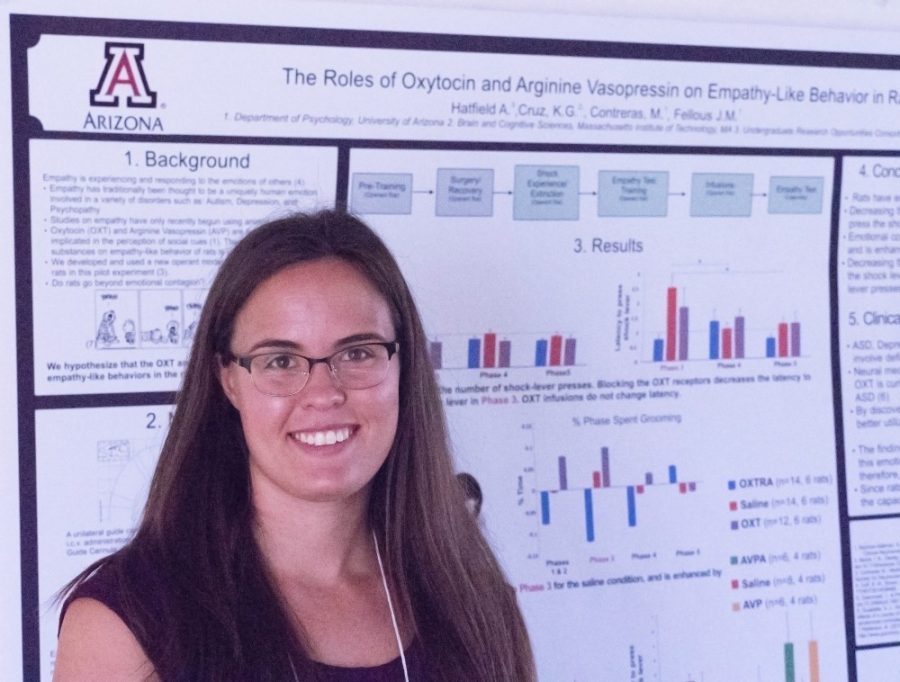The University of Arizona’s Mall will trade board shorts and ultimate Frisbee for cardboard tri-folds and scientific inquiry on Wednesday, Feb. 21. The Graduate and Professional Student Council will host the 26th annual Student Showcase from 9 a.m. to 3 p.m.
Similar to a high school science fair, but set outside to take advantage of Tucson’s early spring weather, the event is meant to showcase research and findings from graduate and non-graduate students alike.
Patrice Moritz, GPSC events director and a first-year graduate student in speech-language pathology, called the event a “celebration.”
RELATED: GPSC Notebook Feb. 5: Engagement with other grads a concern
“It’s a real professional development opportunity,” she said. “The judges that come around are from all different backgrounds, so [the students] have to explain their research free of jargon. That opportunity to talk about what they work on to a different group than just their colleagues is valuable.”
Moritz confirmed that, much like a common science fair, participants’ research will be laid out on tables bearing 3-by-5-foot cardboard posters.
However, the research presented during the showcase promises to be much more than common, with an appeal to a wide range of interests.
There are four competition categories: community and society, education, creative expression and research. Within those categories, entries promise to have rich variety, according to Moritz.
“Any type of research is welcome on the field,” she said. “It’s for graduate and undergraduates, so you see a lot of diversity.”
An example of that diversity can be found in Celeste Atkins’ presentation. A first-year doctoral student studying higher education, she also serves as the department chair for Social and Behavioral Sciences at Cochise Community College in Sierra Vista.
Her presentation stands out among other research projects. Titled “Colored Girls and Controlling Images: Using Multiracial Feminism to Transform Pedagogy” and competing in the education category, Atkins took an out-of-the-box approach.
“My project is actually not a research project; instead, it is a reflective essay,” she said. “I reflect on my journey from a fear/contradictory-based pedagogy to a pedagogy grounded in multiracial feminist theory and focusing on evidence-based techniques and best practices.”
Though her project is different, Atkins feels it is applicable to educators at many levels and reflects not only what she feels are best practices, but an integration of her own lived experiences.
“As a black woman teaching about privilege and other topics in sociology, I face certain challenges due to my race and gender that make it sometimes necessary to create a hierarchy in order to get respect from certain students,” she said.
Other students approached the showcase as a way to highlight their ongoing research. Kaitlin Porter, a second-year French graduate student, focused her project, “Analysis through Illustration,” on her master of arts thesis.
Her work centers on critically analyzing over 80 illustrations from the French novel, “Elle Sera de Jaspe et de Corail” (“It will be Jasper and Coral,” in English).
“My argument is that drawing is a form of language congruent to that of written language,” she said. “It is a justifiable means of processing, analyzing and demonstrating proficiency in literary theories and criticism.”
Porter said events like the showcase are vital for the cross-pollination of ideas from one discipline or field to another.
“I think sharing research is very important, especially across disciplines,” Porter said. “I want to show others what I have been working on, just like I want to see what others are working on.”
While participants will be sharing ideas and research, the event also features prizes for the best presentations in each category. According to the showcase website, $15,000 in awards were given out last year.
Moritz said this year will be similar.
Judges from various backgrounds will be paired and, after a few rounds of voting, will decide two winners in each category: The President’s Award, which comes with a cash prize of $750, and the second place winner, who will be awarded $500. Undergraduate and graduate students compete separately.
On top of those awards given out by GPSC, external awards, such as the BIO5 Innovator award, will also be bestowed, Moritz said.
However, that money prize wasn’t what motivated every participant who entered the showcase. Porter wasn’t even sure there were prizes or awards.
“I hadn’t thought about this, I don’t know what the prize even is, actually,” she said.
On the other hand, Atkins already knows what she would do with her prize money if she wins.
RELATED: GPSC Notebook Jan. 22: Two new reps sworn in
“I would like to buy a large monitor and a wireless keyboard for my home,” she said. “I work on a laptop both for teaching and for graduate school, and the eyestrain and sore shoulders are a challenge.”
Ultimately, Moritz said she hopes students — both those participating in and visiting the event — learn and have fun.
“This is more of a community event,” she said. “We are bringing in the community by showing them what we have to offer at U of A.”
Follow Eddie Celaya on Twitter















